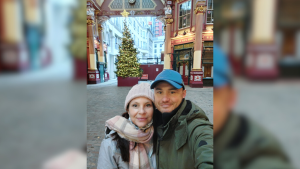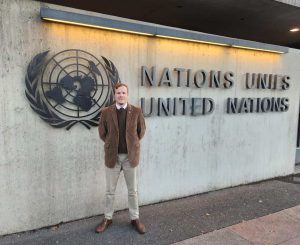By Dr. Sulette Ferriera
Emigrants’ experience of a virtual baby shower as a modern adaptation of an age-old ritual highlights the innovative ways families maintain their bonds despite physical separation.
The image of a stork carrying a newborn baby in a bundle is one of the most recognisable symbols associated with childbirth and parenthood. This iconic figure, with its deeply rooted symbolism of birth and care, has transcended cultural boundaries to become a central theme in baby showers around the world.
The narrative that storks deliver babies is particularly popular in European folklore. It expresses the universal desire for children and the joyful anticipation of new life. The connection between storks and babies likely stemmed from these birds’ springtime return to Europe, coinciding with a noticeable increase in human births. This was seen as the storks bringing new life, a notion that was both literal and symbolic.
This tradition is not new; in the American colonial era, women held “birthing parties” at the home of the mother-to-be. These gatherings, which included midwives and close female family and friends, provided support and strengthened community ties during labour. The attending women would tell jokes, soothe and encourage the mother, and trade recipes.
Beyond the surface celebrations lies a deeper significance. This rite of passage is a celebration of new life, the reaffirmation of familial ties, the extension of emotional support and an opportunity to shower the mother-to-be with essential items for the baby’s arrival – from practical necessities to heartfelt gifts, the generosity of friends and family helps ease the transition into parenthood.
In an era where globalisation and emigration often separate families, in-person celebrations are fading as virtual spaces have become venues for celebrating traditional milestones. The stork tea is one such ritual adapting to the digital age.
Emigration adds complexity to new life
With the emotional complexity of emigration, life’s major milestones, such as birthdays, graduations, baptism ceremonies, engagement parties, weddings, and funerals, take on a new dimension. Usually celebrated with rituals, these events now acquire a melancholic undertone, a kind of homesickness, since the emigrant and their loved ones are rarely physically together to celebrate these milestones.
Emigration marks a departure from the familiar and a plunge into the unknown. At the heart of every emigration is a multitude of conflicting emotions – excitement and joy, longing and sadness, nostalgia and pride. Imagine a mother learning about her immigrant daughter’s pregnancy an ocean away. She is filled with excitement and anticipation, yet also feels a subtle heaviness in her heart:
“In just under a month, I’m set to embark on a new phase of my life as a grandmother. They say that being a granny is a life-changing event. Despite the excitement bubbling within me, there is also a heaviness in my heart. I feel left out. My daughter is halfway across the globe, and I can’t be there …”
Pregnancy is a transformative period that deepens the bond between a pregnant mother and her own mother. Traditionally, this time is marked by increased closeness, sharing of wisdom and emotional support. Mothers pass down their experiences and offer guidance, while daughters seek comfort and reassurance.
However, when a daughter is geographically distant, this natural evolution in their relationship is challenged. Emigration is more than a physical move – it is an emotional journey that redefines identities, celebrations, and family relationships.
For the mother, not being physically present to support her daughter can lead to feelings of helplessness and sadness. She may struggle with the inability to provide the same level of care and attention she might offer if they were nearby. This distance can also amplify the mother’s concerns and anxieties, as she relies on updates rather than firsthand observations.
For the daughter, the absence of her mother during such a significant life event can be profoundly challenging. She might miss the comfort of her mother’s physical presence and the security that comes with it. The daughter may also feel a sense of guilt for being far away and causing her mother to miss out on this milestone.
Physical separation creates a barrier to the intimacy that usually flourishes during pregnancy. Simple moments, like feeling the baby kick or discussing nursery plans, are experienced through phone calls and video chats instead of face-to-face interactions. This can lead to feelings of isolation and longing on both sides.
Virtual baby shower as a rite of passage
For the emigrant, a baby shower takes on added resonance. It reminds them of the bonds that endure across miles and continents, anchoring them to their roots even as they forge new paths. Through these gatherings, migrants find solace in the familiar rituals of home, forging connections that transcend physical distance. Family members may participate in the event through videoconferencing.
Without a global positioning system (GPS) as a guide or familiar pinpoints, this uncharted space represents a journey into the unknown that touches everyone involved. Most transnational families create their own private rituals to deal with their loss, seeking solace in the familiar rhythms of the past.
Baby showers used to be a gathering of women, close relatives and friends. Today, virtual gatherings become the next best thing as we are separated by distance. Information communication technology enriches the landscape of transnational relationships. Virtual connections through cell phones, email, social networks, and video calls serve as critical lifelines to bridge the physical distance between people, helping to strengthen family ties.
One mother recalls: “As I watched the screen light up with the smiles of my family, miles apart yet connected by technology, I felt a mixture of joy and longing. The virtual stork tea for my first grandchild was not what I envisaged; it was bittersweet. We had our teacups ready, along with koeksisters and milktart. The silence of physical absence echoed loudly. Each gift being unwrapped and each piece of advice shared reminded us of the vast distance between us. I longed to touch each Babygro, to share whispers and laughter without delay, to smell the baby powder. I can’t help but wish for a time when hugs replace screens.”
Rituals have evolved over the centuries as timeless practices that guide our passage through life. They punctuate our existence from the tenderness of birth to the solemn finality of death, marking each significant moment with shared meaning.
Rituals establish a societal arena where emotions can be freely expressed within cultural bounds, fostering active engagement within our personal social circles. They remind us of who we are, where we come from, and the ties that bind us together.
In the context of emigration, rituals play a pivotal role in dealing with the unknown. These virtual gatherings are more than mere technological conveniences; they are lifelines.
These familiar metaphors and symbols offer a universal language where words sometimes fail.
Virtual baby showers make the important moments count
It is our inherent need to share life’s significant moments – like the birth of a child – with those who matter most to us. In a world where emigration often means missing out on significant life events, the power of rituals to maintain connection and foster unity cannot be overstated.
Though the physical presence is painfully missing, this unique way of celebrating new life affirms the resilience and adaptability of transnational families. The stork, with its migratory nature, embodies the spirit of these rituals, symbolising the journey, adaptation, and unyielding bonds that unite families across continents.
In this digital world, our adaptability not only reinforces the essence of family but breathes new life into our most cherished traditions.
By embracing modern adaptations of age-old practices, we create continuity amid change, ensuring that we remain part of a larger family narrative no matter where we are. This modern adaptation holds true to the spirit of traditional rituals, ensuring that no member, no matter how far, is left out of the family’s circle of life, similar to Ohana (Ohana is a Hawaiian concept that stresses the importance of family, friends, and community in life).
They remind us of who we are, where we come from and that we are part of something greater than ourselves.




















